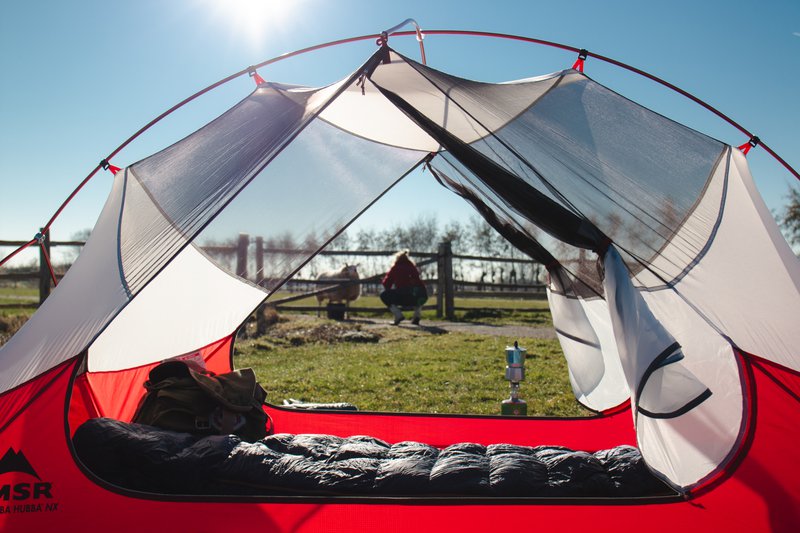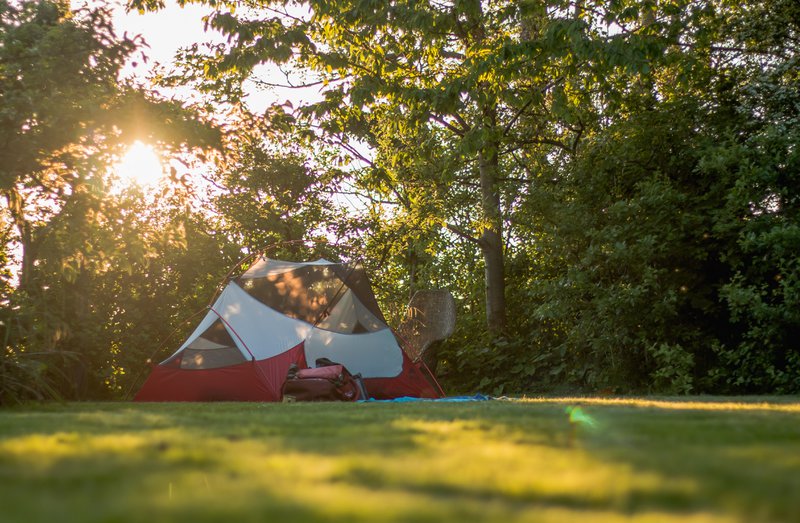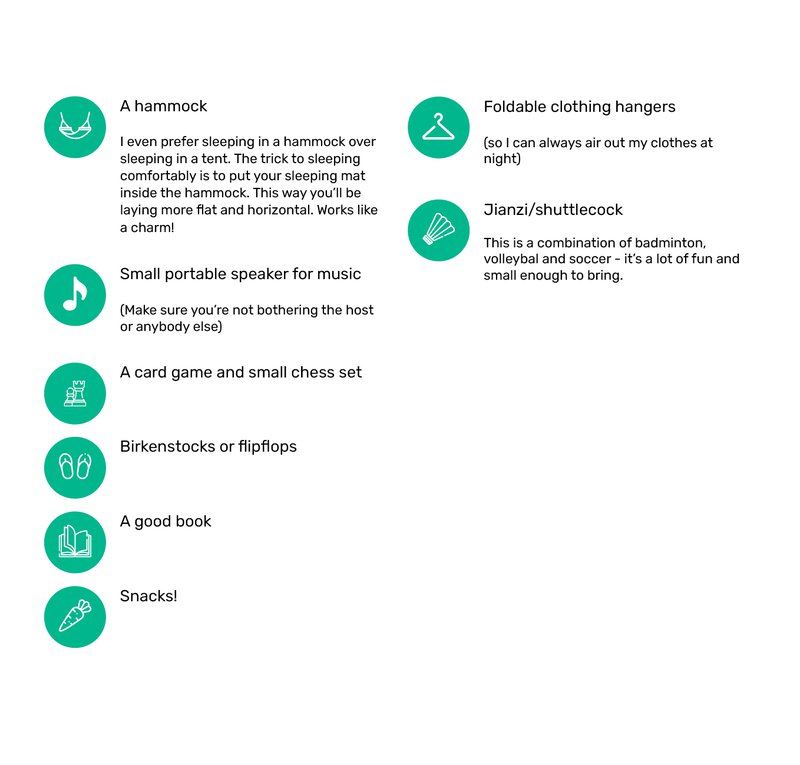
Freedom of nature
Sustainable getaways
Real human connections
What to bring when camping in a tent
Unsure what to bring when camping in a tent? Elisabeth shows you her personal packing list and also shares some useful information on what to focus on when investing in new or second hand camping gear.
Camping enthusiasts will agree: you can enjoy nature to the fullest when you go camping. No wonder, because you’re outside from dusk till dawn, to enjoy everything surrounding you. Enjoying nature is easy to do in short intervals – but when you plan to spend the night outdoors, having the right gear with you is crucial if you want to keep the good times going.. Not only to make sure you can camp comfortably, but also to protect you from the elements. There’s a saying in Scandinavia stating: there’s no such thing as bad weather, only bad clothing. The same is true for camping gear. My name is Elisabeth, I’m an outdoor enthusiast, photographer, traveller and part of the Campspace Team. Within this article I’ll try to help you with a checklist on what to bring when camping in a tent. I’ll explain some products in depth and will share my personal packing list with you as well.


Sleeping bag
Some of the items on the list might need some more explanation. For example: what type of sleeping bag do you need to bring when you go camping? Like with most items: the materials decide the qualities a sleeping bag has. Down is often more lightweight, more warm, and smaller in packing volume. Whereas cotton is a lot cooler, bigger and heavier. Synthetic materials can be a bit of both and you could say, are in between the two.
When buying a sleeping bag you can take three main things into account: packing volume, weight and the comfort temperature. All of these should fit your needs and wishes. Sometimes that’ll mean you need to compromise a little on one or the other. When you like to go camping both in the fall and winter, or you like to camp in the mountains, (where it tends to be colder) you’ll need a sleeping bag with a lower comfort temperature. You’ll notice that down sleeping bags fit that description. These are also more expensive, due to the fact that down is a more expensive material. Try to realise that staying warm while sleeping is crucial for getting enough rest. Otherwise, you won’t be able to enjoy yourself during the day either, because of pure exhaustion.
It’s an investment for sure, but when you buy the right gear, you’ll enjoy your trip more and are also more likely to go on another trip after this one. You’d be right in guessing that even the warmest sleeping bag won’t keep you warm if you’re laying on an icy cold floor. Choosing the right sleeping mat is therefore just as important as investing in a good sleeping bag.

Sleeping mat
What to bring when camping in a tent does not only mean a good sleeping bag. The packing volume and weight are very important when choosing a sleeping mat, just as it is with a sleeping bag. Another thing to consider is the material and isolation level. The smaller the packing volume, the thinner and more fragile the material will often be. Take into consideration that when choosing a thinner material, you’ll need to be more aware of where you lay down your mat, since your surroundings will be less forgiving.
Air mattresses are often smaller in packing volume, and they’ll be the lighter choice in many cases too. The chances you’ll tear a hole in them is bigger though, and the isolation level (warmth) is often rather low. Sleeping mats with foam are a bit more tough and robust, but every material and mat comes with pros and cons. A foam mat will have a higher isolation level, which is great for camping in lower temperatures, but these mats are often more difficult to deflate and to roll up.
Another thing to consider is the position you sleep in. When you’re someone who likes to sleep on their side, you can imagine that there’s a focused point of weight at the hip. Many lightweight foam mattresses aren’t that thick and might not give you the support you need. In such a case, a foam mattress with a bigger packing volume or an air mattress might be the solution for you. Those who sleep on their bellies or backs will have it a little easier, because there’s less of a focus point in weight. Make sure to ask for advice in the store and ask if you can try the sleeping mats out. This way, you’ll get a better feel of what works for you.
Tent
When thinking of what to bring when camping in a tent, the tent itself is obviously quite important. Buying a tent is a big investment, so it should be something you think through and consider carefully. When a tent fits your needs and wishes, you’ll enjoy camping a lot more, which in its turn will cause you to use it more. When you’re in a store to buy a tent it can be overwhelming. What is it you need to focus on when you buy a tent? I’ll try to give you some information that can help you decide which tent is the best one for you.
Weight and Volume
Do you want to bring your tent in your backpack, on your bike or does it only need to fit in your car? Personally I prefer a lightweight tent. However, lightweight tents are often a little less robust and aren’t very well suited to stand in the sun and rain for many days in a row. The material will deteriorate due to UV and rain, causing the waterproofness to deteriorate as well. If your camping style is to stay at the same spot for a couple of days in a row, instead of trekking, hiking or biking - a heavier and more UV-resilient tent is the better choice for you. Cotton is, for example, a material that can withstand UV and rain a lot better. This shows you that weight and volume aren’t just numbers that stand on their own: the materials that influence these factors are just as important.
Waterproofing
There are many misconceptions about waterproof material. When the packaging of a product mentions ‘waterproof’ or ‘100% waterproof’, this does not always mean that there’s no limit to it. A completely waterproof tent would not provide proper ventilation, which would make it very warm and sweaty, not to mention you wouldn’t be able to breath properly. A ‘waterproof’ tent or piece of clothing, means that the outer layer of the material has been treated with a waterproof material or coating. What exactly that treatment is and what it’s specifications entail, is measured in different ways. I’ll focus on the watercolumn in millimeters. The watercolumn shows you the water pressure the material can withstand. To put this into perspective: there are tents with a watercolumn of 800mm (rather a low watercolumn) up to roughly 10.000 (very high watercolumn) - with lots of options in between and even some with a higher number.
The higher the number, the longer the material will keep the rain out and the longer the tent can withstand heavier rainfall. The same goes for waterproof clothing. Only, the watercolumns of waterproof clothing are often a little higher (roughly in between 5.000mm and 30.000mm). Due to the way we use clothing, the initial watercolumn needs to be higher, as the material folds and bends more, and the material will deteriorate and wear out faster due to usage.
Waterproofing in practice
The watercolumn that you get with a brand new tent won’t last you forever. As mentioned above, UV, air pollution and general usage will deteriorate the coating and waterproof material that determine the watercolumn. Lightweight tents often have a watercolumn that is more on the low spectrum (1500-2000mm). The idea is that when you buy a lightweight tent, you’ll use it while hiking. Meaning you won’t leave it out in the sun or rain for days on end. A lower watercolumn should be sufficient enough for that type of usage. If you decide to use a tent with a lower watercolumn differently, keeping it out in the open for a longer period, it will deteriorate and the watercolumn will drop quite a lot. The tent might not protect you sufficiently against the rain anymore after that.
Setting up your tent also has a big impact on the waterproofing. If the material of the tent is folding somewhere, or the tension on the material is missing - the watercolumn won’t work as well. You need to help the tent along, making sure water doesn’t get the opportunity to increase the pressure by accumulating and laying still on top of the material. I personally compare this to sitting on a wet surface with rain pants on. If the water can’t go anywhere but towards you, the water pressure increases too much and the material won’t hold. Simply put: the water can’t go anywhere else, so it’ll be forced into the waterproof material.
Be realistic and don’t expect miracles from your tent. Make sure to get advice from someone at a store where they know what they’re talking about and try to look for favourable bargains or deals on tents. Maybe even buy one second hand that hasn’t been used much? As soon as you’ve purchased your own tent, camping will be much cheaper than when you have to rent a tent or cabin, or book a hotel. You can easily earn back the money you’ve invested in your tent this way.

Leave No Trace
Maybe you’ve already spotted some items in the packing list: biodegradable toiletries and detergents for example. Let me ask you this: have you ever brushed your teeth right outside your tent? Spitting out your toothpaste on the ground, washing it away with some water? You’re definitely not the only one. Many people don’t realise that toothpaste isn’t a natural product and it’s full of chemicals, harming the environment when spreading it around in nature.
Luckily you can avoid polluting the environment this way, by using biodegradable products. You can find shower gels, shampoos, toothpaste, dish soap and laundry detergent in a biodegradable form nowadays. For example Sea to Summit produces something called Wilderness Wash. They also have many other options for more specific usage. The brand Seepje also makes soapblocks that you can use to do your laundry with while on the road. Try to be aware of the products you use and what you’re leaving behind when you leave your pitch. Try to leave no trace.
Make sure that you leave your campspace or any place that you camp at neatly and just like you found it. Campspaces are treasures in nature and we should keep them that way. Make sure you always bring a garbage bag with you, so that you can collect your rubbish and bring it to a bin afterwards, leaving no trace behind. Or as they say: leave no rubbish, only footprints!
Personal camping gear
Now that we’ve covered what to bring when camping in a tent, as promised in the intro, I’ll share some personal favourite items that I always bring with me on every trip:

Did this article help you with what to bring when camping in a tent? I might be missing some items on my packing list. Please let me know if you have some additional items to add!
Find your sustainable getaway
Up to 95% CO2 reduction if you book a campspace adventure. Learn more